Please Take Note: This is a review of the final game, but it might change slightly based on the success of the Kickstarter campaign. The game is being reviewed on the components and the rules provided with the understanding that “what you see is not what you might get” when the game is published. If you like what you read and want to learn more, we encourage you to visit the game publisher’s website or visit the Kickstarter campaign. Now that we have all that disclaimer junk out of the way, on with the review.
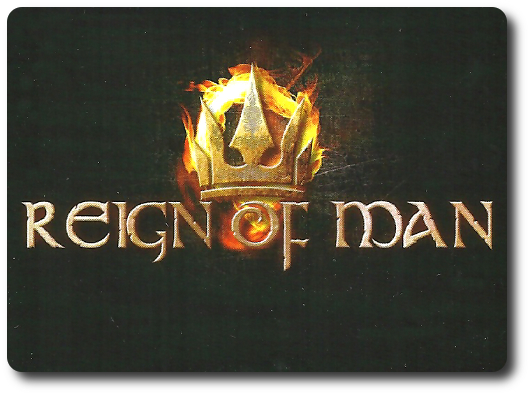
The Basics:
- For ages 8 and up (publisher suggests 13+)
- For 2 to 5 players
- Approximately 30 minutes to complete
Geek Skills:
- Active Listening & Communication
- Counting & Math
- Logical & Critical Decision Making
- Reading
- Strategy & Tactics
- Risk vs. Reward
- Semi-Cooperative & Team Play
- Hand/Resource Management
- Worker Placement & Area Control
Learning Curve:
- Child – Easy
- Adult – Easy
Theme & Narrative:
- Command your forces and raise a mighty empire
Endorsements:
- Gamer Geek mixed!
- Parent Geek approved!
- Child Geek approved!
Overview
Empires are forged from war. Even the smallest keep can become the largest capital. What it takes is a leader with vision, courage, and the ability to command. You believe yourself to be such a leader and dream of ruling the largest empire known to man. But you’re not the only one who has this dream…
Reign of Man, designed by Sam Oplinger and to be published by Wicked Grin Games, will reportedly be comprised of 1 Map game board (double-sided), 1 Command token, 10 tarot-sized World Event cards, 5 sets of 24 Army tokens (double-sided), 5 Empire mats, and 6 Battle dice (standard six-sided dice). As this is a review of a prepublished game, I cannot comment on the component quality. The provided artwork is very clean and blends well with the game’s thematic elements.
The Dawn of Empires
To set up the game, first place the Map game board in the middle of the playing area. Depending on the number of players, place the full map face-up (3-5 players) or select 1 of the 2 hemispheres (2 players).
Second, shuffle the World Event cards and place the deck face-down next to the Map game board. This is the World Event draw deck for the duration of the game.
Third, each player takes 1 Empire mat and all tokens of a single color. Note that the Army tokens are double-sided with 1 side always in black. Place Army tokens with the black-side up on each of the spaces on the player’s Empire mat except those in the first position of each row (the left-most circle).
Fourth, each player rolls 1 Battle die to determine the order in which players select their empire domain noted on the Map game board. The highest player goes first followed by the second highest and so on until every player has selected an empire.
Fifth, players now place their Army tokens, color-side up, in each of their selected empire regions.
That’s it for game set up. The player to select their empire last is given the Command token and is the first Command player.
Empire Rising
Reign of Man is played in rounds and turns. There are no set number of rounds per game. The first player of a round is referred to as the “Command player” and completes a small number of tasks before their turn. After the Command player takes their turn, the next player in turn order sequence takes their turn and so on until the turn order comes back to the Command player. This marks the end of the round and the Command token is passed to the next player in the turn order sequence, marking the end of one round and a start of another.
Phase 1: Command Player Only
This phase of the round is only completed by the Command player and only once per round. All other players can sit back and watch the drama unfold.
The Command player draws the top-most World Event card and reads it out loud. It’s then placed next to Map game board underneath the “In Two Turns” space. A World Event card already occupying the “In Two Turns” space is pushed to the “In One Turn” space. Any World Event card in the “In One Turn” space is pushed to “This Turn” space. In this way, World Event cards are always moving and coming closer to being activated, giving players enough time to consider how best to prepare or benefit from them.
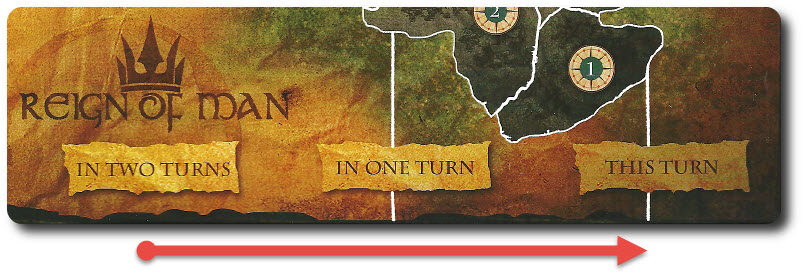
When a World Event card is pushed to the “This Turn” space, the Command player reads it out loud and it’s immediately resolved. World Event cards are not all bad and the majority of them are meant to slightly alter the game rules and introduce temporary change. Not all players will be impacted all the time, as some of the World Event cards only target players that meet certain criteria. Regardless, all players will see the inevitable coming and be able to adjust their strategy accordingly.
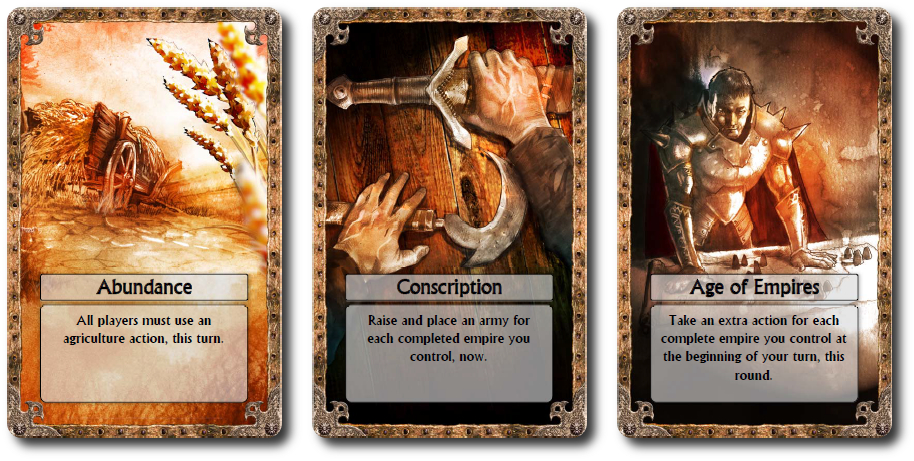
Phase 2: Take Turns
After the Command player completes phase 1 for the round, they take their turn. After they complete their turn, the next player in the turn order sequence takes their turn. Phase 1 for the round is not used again until the next round begins.
A player’s turn consists of taking 1 action. The number of actions available to them will initially be small and all players start with the same actions as their opponents. As the game continues, Army tokens are removed from the player’s Empire mat which unlocks additional actions. Some World Event cards will also provide an action.
Through the progression of the game, the type and number of actions a player can take will begin to be very different from their opponents, as will their passive abilities. This allows the player to build upon their Empire in accordance to their strategy and tactics.
There are 3 categories on the Empire mat. These are Civilization, Military, and Agriculture. Each focus on different areas of an empire’s advancement.
- Civilization: Initial ability allows the player to unlock 1 development on the Empire mat by removing the left-most Army token of any of the 3 categories and placing it, color-side up, above the Empire mat that can later be raised as an army. Continued advancement allows for sea travel, an additional action, and 1 victory point.
- Military: Initial ability allows the player to move 1 or more Army token in a single territory to an adjacent territory (more on moving and attacking below). Continue advancement allows for strong armies, better mobilization, automatic removal of opponent Army tokens, and 1 victory point.
- Agriculture: Initial ability allows the player to place 1 Army token above their Empire mat to any territory they currently already occupy. Continued advancement provides for better defense, larger army placement, and 1 victory point.
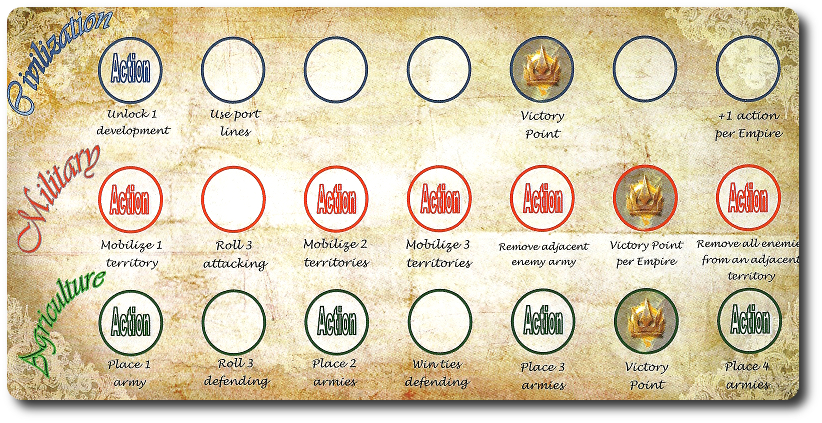
After the player has taken their action (or actions per their advancement and possible World Event effects), their turn is over and the next player in the turn sequence takes their turn until the round comes to an end.
Army Movement and Combat
Initial Army token movement is completed by moving 1 or more Army tokens from one territory to an adjacent territory. These Army tokens need not all move to the same territory. As the game progresses, the player will be able to mobilize multiple territories on their turn. The only restriction is that a single territory cannot be mobilized twice per single action. Lines connection different continents on the Map game board are referred to as “Port Lines”. These can be used if they have been unlocked and allow the player to move from one continent to another as if they were adjacent territories. They also allow the player to move around the “world”, exiting from the left side of the map and entering through the right side.
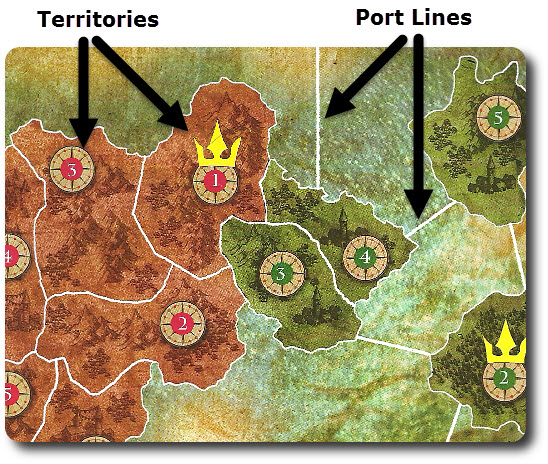
Note: The numbers found in the territories are not used in the core game. They are used in the game variant and dictate the placement and movement of enemy forces.
If 1 or more Army tokens are mobilized into a territory where 1 or more enemy Army tokens are located, combat ensues immediately and the player cannot continue with their turn until combat is resolved.
Combat involves each player with an Army token in the same territory taking dice and rolling against each other. One die will be rolled for every Army token and no more than two (future unlocked abilities will allow the player to attack with more dice). The results are then compared. All ties are ignored (unless an ability says otherwise). High numbered rolls destroy (remove) lower numbers. Each player compares their rolled results by comparing their highest and moving down to their lowest. If one side is rolling more dice, they have a better chance of being successful. Combat continues until only 1 army color remains in the territory. Removed Army tokens are taken by their owner and placed above their Empire mat for future placement.
While it might not sound like such a big deal to have your Armies removed, a player loses the game if at anytime they do not have any Army tokens on the Map game board. Their empire has fallen and they must now watch and sulk as the game continues without them.
The Greatest Empire
The game continues until 1 player has earned 3 victory points. Victory points can only be earned by unlocking them on the Empire mat. Alternatively, if only 1 player is left in the game, they win by default. Without any other empire to contend with, the player’s empire grows to be the greatest in history of mankind.
March of the Damned
Possibly included with the core game is a game variant titled Reign of Man: March of the Damned. This game variant explores a darker side of the game, introducing evil magic, intelligent undead, and a Lich Queen with aspirations to rule the world. Instead of the players working to build and control the largest empire in the land, they will be working together to save their individual empires from the Lich Queen. But the alliance will be short-lived. Once the players’ common enemy is defeated, they will once again compete to create the strongest empire in the history mankind.
All of the core rules of the game apply, but none of the players can use the World Event cards until the Lich Queen is defeated. The players also use a new Empire mat that has an Influence track. The influence represents the player’s ability to rally the country, feed the starving, and rebuild what the Lich Queen has destroyed. Players start with few Army tokens and must raise more before attempting to defeat the Lich Queen and her Army tokens. If the player loses Army tokens, the fallen army become the property of the Lich Queen who gladly enlists them into her undead forces.
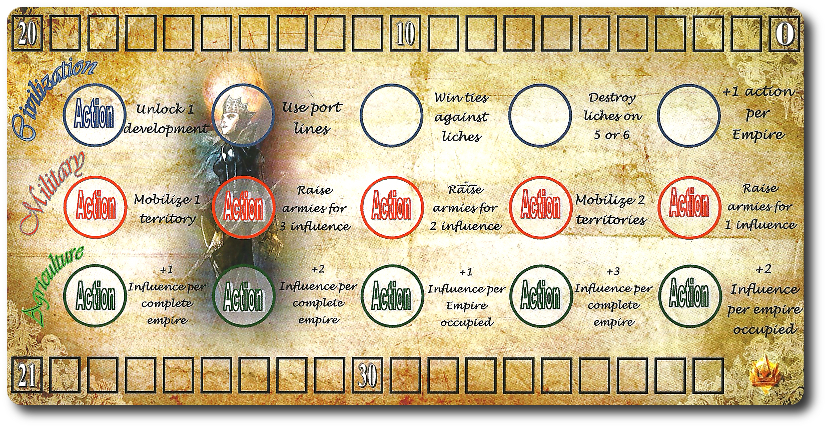
The Lich Queen and her minions move about the Map game board by means of random direction determined by the roll of the dice. This erratic and random marching makes it difficult to determine where the Lich Queen will move to next. A player might find his forces suddenly flanked or the enemy retreating to a corner of the world that cannot be reached.
If the player no longer has any armies, they are out of the game. Until the Lich Queen is defeated, the players cannot build their empires. This is a difficult and demanding expansion that will test a player’s ability to strategize and use tactical movement to avoid the Lich Queen until the final confrontation. It also works very well as a precursor to the core game. As the countryside is brutally destroyed, the players must rebuild the land and its people from the ground up after the Lich Queen destroys it.
House Rules
Many of our more skilled players felt that the core game was lacking enough to keep them interested and engaged for a long period of time. They developed a few game variants of their own that they enjoyed and wanted to share with you. These are not part of the standard rules of the game.
Fallen Empires
When a player’s empire territory with the crown insignia is claimed by an opponent, the player is out of the game and the opponent earns 1 victory point. Any Army tokens owned by the player are flipped to the black-side and remain in the territory. These represent the remains of the fallen empire army and they will attack any Army token that enters its territory.
Fortifications
The number value on each territory is a bonus to defense that is given to the player who is defending the territory from invaders.
Army Capacity Limits
The number value on each territory represent how many Army tokens can be located in that territory at any particular time. Army tokens passing through do not count. The number value is meant to represent a number of different things. Food available for soldiers, tolerance of soldiers in the territory, and difficulty to house an army.
Diplomacy
While the rules do not specifically state that players cannot make deals with each other, this house rules provides it and gives a few suggestions. First, players can agree to team up on other opponents. Second, agreements can be made to not attack certain territories, use certain Port Lines, or cross certain boundaries. Third, all agreements must be made in the open at the gaming table. Fourth, all agreements are non-binding.
Different Empire Mats
This was a really interesting experience. A small group went off and created different Empire mats based on the different empires in the video game Wither. The end result appeared to be a well-balanced Empire mat for each player, but with different abilities when the players advanced. Each player then conducted themselves in the game balancing the pros and cons of each force. It worked and gave each player a feeling of playing a unique empire that was all their own.
Limited Resources
The rules do not specify if the removed Army tokens are out of the game or can be used again by the player. We collectively agreed that they could come back in the game, but some of the players didn’t like this approach. Instead, they played the game using the Army tokens as a limited resource. Once they were off the Map game board, they were out of the game. This made larger armies almost impossible to stop, but it did create for a faster game.
To learn more about Reign of Man, visit the game publisher’s website or visit the Kickstarter campaign.
Final Word
The Child Geeks quickly learned how to play the game and got to it. One Child Geek exclaimed, “I thought this game was going to be like Risk, but it’s much harder and more interesting.” Another Child Geek said, “I really like how you get to improve your empire and get the benefits right away.” The Child Geeks even acted and reacted well to the World Events, tailoring their turn to take advantage of global effects. The only aspect of the game they had trouble with was the combat. As one Child Geek put it, “I think it is a bit clunky or maybe I’m just not getting it. I want to roll more dice.” As in, 1 die per Army token. Makes sense, thematically speaking. Regardless, all the Child Geeks voted to approve Reign of Man.
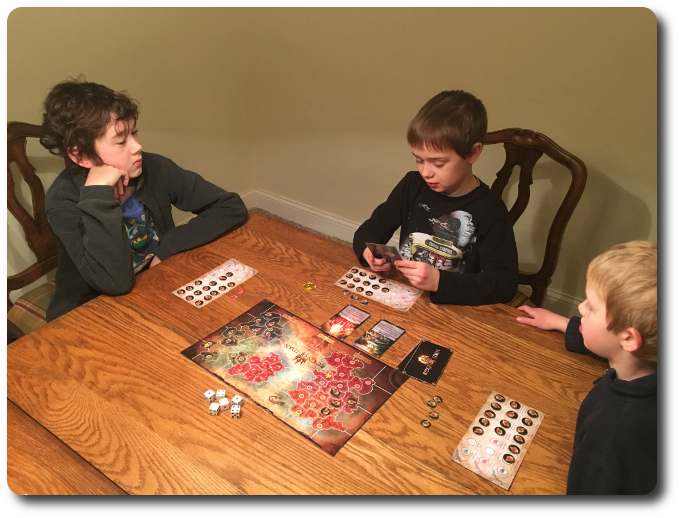
As the World Event is read aloud, the players listen and carefully consider how to profit from it
The Parent Geeks found the game to be fun with their children, their families, and their friends. According to one Parent Geek, “I like how the map you play on changes based on the number of players. Makes the game feel more tailored to you.” The Parent Geeks also enjoyed the straightforward game play that was challenging enough to keep them thinking, but not so difficult as to keep them guessing. As one Parent Geek put it, “I like games that give you freedom to make choices and enough information to help you make that choice.” The Parent Geeks were a bit skeptical of the World Events, finding random effects to be more of a nuisance rather than a game enhancer, but they changed their mind after the first game was over. Instead of a causing problems, it made each turn feel unique, introducing a new slant on how to approach the game. All the Parent Geeks voted to approve Reign of Man.
The Game Geeks were a bit torn. On one hand, they found the game to be surprisingly deep and tactical. Strategic game play was not only possible, but essential to victory. The Map game board was big enough to allow for growth, but not so big as to allow players to hide from each other. This was a game that encouraged decision making, rash action, and risk taking. It rewarded those who took action rather than retreating. Where the game fell flat was its lack of replay and a strong feeling that it was incomplete. According to one Gamer Geek, “This game has all the makings of something wonderful, but it doesn’t feel like it is done. Or, better put, it feels like the designer is holding something back.” Another Gamer Geek said, “I want to approve this game, but I can’t at the moment. I don’t think it’s finished.” What the Gamer Geeks were seeing is what many of our other groups saw, too. The game appears to be open-ended, even after you finish it. Because of this, about half of the Gamer Geeks approved the game for what it was and could be, while the other half rejected it for being what they believed to be a half-baked cake.
The rules of the game at the moment need work. They read like a summary provided by the game designer at the demo table. A lot of little details are missing. For example, what happens to the Army token when they are removed? How do I move multiple Army tokens into multiple territories? There are also some visual examples that would be helpful. For example, showing how combat is resolved with different sized armies. There isn’t even a summary of each unlocked ability. Lack of such information would normally make it difficult to learn, let alone play, the game. Not the case with Reign of Man. Missing information is frustrating, but the game play is intuitive enough to allow the players to determine the best course of action. The problem, however, is that there are a lot of players who do not have the time or patience to figure a game out.
This is a game ripe for more game variants and expansions. Its simple method of advancement, movement, and conflict are the perfect base for subtle changes and bigger challenges. For example, it would be very easy at home to create 4 new Empire mats with new abilities and actions. It would also be easy to re-theme the game by providing every player with an Empire mat that focused on colonizing Mars rather than building fantasy empires. The World Event decks also offer many opportunities, either by supporting a new thematic element in the game or making the game much more difficult by introducing temporary new rules. The whole game itself appears to be parts of a game system that just happens to all fit together. That’s exciting to me because it strongly suggests that adding more value and customizing the game easily was part of the original design.
But there is a downside. All of our players felt that something was missing or wanted more. The game is complete as it is, yet strangely incomplete at the same time. It’s like a burger with just a bun. No condiments, no lettuce, and no tomato. The burger is technically ready to eat, but few would suggest it is complete. That’s the state I and many others found Reign of Man to be in. Engaging and enticing, but leaving most players wanting more.
Whether or not this game is for you will depend on a few things. If you are looking for a middle of the road and easy to learn Wargame, Reign of Man is for you. If you like games that easily allow for customization and homemade expansions, then Reign of Man will be a delight. If you get that itch to play a mix of command and conquer, then Reign of Man is for you. If you fall into any of these groups, do take a look at the game. I, for one, am very pleased with it.
This is a paid for review of the game’s final prototype. Although our time and focus was financially compensated, our words are our own. We’d need at least 10 million dollars before we started saying what other people wanted. Such is the statuesque and legendary integrity of Father Geek which cannot be bought except by those who own their own private islands and small countries.




Another marvelously honest and thorough review, thank you guys!
It was our pleasure.
Thanks! I’m going to proove the print and play version.